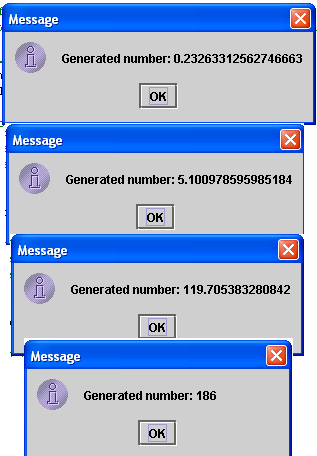

topic = " banana " ) ) Multiple context stores For example, this function would sendĪnything on topic banana to the second output rather than the first: if ( msg. This makes it easy to write a function that sends the message to different Is more than one output, an array of messages can be returned by the function to The function edit dialog allows the number of outputs to be changed. See logging section below for more details. Use node.warn() to show warnings in the sidebar to help you debug. Nodes should return the message object they were passed having made any Msg.res properties to be preserved end-to-end. Covering popular subjects like HTML, CSS, JavaScript, Python, SQL, Java, and many, many more.
#ADDING PARAMETERS TO MATH.RANDOM JAVA FREE#
This will break some flows,įor example the HTTP In/Response flow requires the msg.req and W3Schools offers free online tutorials, references and exercises in all the major languages of the web. Lose any message properties of the received message.

It truncates (cuts off) the dot and the digits to the right of it, no matter whether the argument is a positive or negative number. : constructing a new message object will Unlike the other three Math methods: Math.floor(), Math.ceil() and Math.round(), the way unc() works is very simple. For a limited stream, we can set the top and bottom for the number generation range: IntStream limitedIntStreamWithinARangeWithSplittableRandom = splittableRandom.ints(streamSize, min, max) 2.5. To clarify, we can choose to have a limited or unlimited stream. Let's say we want to generate random numbers within a specified range, for example, zero to four. randomNumber will give us a different random number for each execution. This means that we can easily get a stream of int values. Math.random () returns a double type pseudo-random number, greater than or equal to zero and less than one. Those work in the same way as we have described before. Also, we have available one- and zero-parameter invocations. So, any of the parameters can be negative. However, it doesn’t check if we work with positive or negative numbers. Otherwise, we’ll get an IllegalArgumentException. It is a function that gives you a random number. This way of using checks that the max parameter is bigger than min. Random random new Random () int array random.ints (100000, 10,100000).toArray () you can print the array and you'll get 100000 random integers. something like this will work, depends if you want double or ints etc. Int randomWithSplittableRandom = splittableRandom.nextInt(min, max) You can use IntStream ints () or DoubleStream doubles () available as of java 8 in Random class. With nextInt we can set directly the top and bottom range using the two parameters invocation: SplittableRandom splittableRandom = new SplittableRandom() We have available the nextInt and ints methods. So, we have to take care when using this class. It’s important to know that the instances are not thread-safe.
#ADDING PARAMETERS TO MATH.RANDOM JAVA GENERATOR#
Īs we can see in the JavaDoc, this is a generator for use in parallel computations. Secondly, and more importantly, we can use the ints method: IntStream streamWithThreadLocalRandom = ThreadLocalRandom.current().ints() 2.4. Int randomWithThreadLocalRandomFromZero = ThreadLocalRandom.current().nextInt(max)

Firstly, we have two variations for the nextInt method: int randomWithThreadLocalRandom = ThreadLocalRandom.current().nextInt() With Java 8 or above, we have new possibilities. Now, let’s see how it works: int randomWithThreadLocalRandomInARange = ThreadLocalRandom.current().nextInt(min, max)

This one has three important differences from the Random class: Java 1.7 release brought us a new and more efficient way of generating random numbers via the ThreadLocalRandom class.


 0 kommentar(er)
0 kommentar(er)
